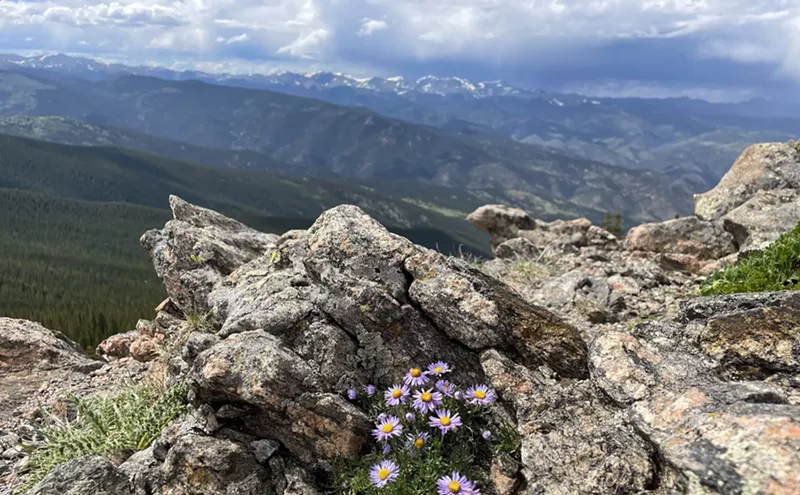In the history of art in the region, artist Birger Sandzén stands out, and not just because his work routinely fetches hundreds of thousands of dollars — though that doesn't hurt. Rather, it has to do with the high quality of his pieces and the way in which his style bridges the gap between post-impressionism and abstract expressionism.
Sandzén was born and raised in Sweden and studied painting there and in Paris — and although he later made a permanent home in Kansas, we Coloradans can claim him as one of our own because this is where he found his muse in 1908, in the form of our stunning scenery. He also spent nearly every summer sketching and painting in Colorado between 1913 and 1952. Sandzén died in 1954.
Much of his work is displayed at the Birger Sandzén Memorial Gallery in Lindsborg, Kansas, which is currently undergoing renovation. This situation, coupled with loans from private collections, provided an opportunity for Blake Milteer, the director of the museum at the Colorado Springs Fine Arts Center, to mount Sandzén in Colorado, a major retrospective of the artist's oeuvre. This may be the largest exhibition ever devoted to Sandzén, and if Milteer hadn't put it on, most of these works would have been in storage or hanging over someone's fireplace. The venue is most appropriate, since Sandzén briefly taught at the Broadmoor Academy, which is the CSFAC's direct predecessor.
The story behind the show begins in 1871, in the small town in Sweden where Sandzén was born to a Lutheran rector and his wife. Early on, he developed an interest in art and acquired his first set of paints as a Christmas gift when he was only eight years old. At age sixteen, he began to take private painting lessons. After attending preparatory school and a year at Lund University, Sandzén made his way to Stockholm to continue his studies. He was chosen by Anders Zorn, one of Sweden's most important artists, as one of a small group of students to be admitted to the school he had founded. Zorn had gained international fame for translating the French impressionist style into a Swedish one. From Zorn, Sandzén learned technique and a new approach to color.
Encouraged by Zorn and facilitated by the sale of several paintings, Sandzén moved to Paris in 1893, studying the following year with Edmond-François Aman-Jean, a symbolist who had a close association with Georges Seurat. Seurat is credited as the inventor of pointillism, a style in which little dots of different colors are used to convey a unified tone in the eye of the viewer as the various shades resolve themselves into singular ones. Sandzén embraced the approach for only a short while, but its influence can be seen throughout his career.
In 1894, Sandzén was offered a job teaching art at Bethany College in Kansas, which had been founded by Swedish immigrants. He was instantly enchanted by the vistas of the plains, especially the unexpected colors all around him. In 1899, he took a trip to Mexico, and it was at this time that he first came to Colorado. In his diary, he wrote: "In Colorado the landscape gradually takes on a different appearance and becomes more and more desolate and wild."
In 1905 and 1906, he took an extended trip back to Europe and became impressed with the advancements in art going on there. In 1907, back in Kansas, his work began to move toward his signature style, in which toned-up colors were used to convey the subject, most often landscape scenes. The next year, he spent several months in Colorado.
This is where the show — which is on the second floor in the main exhibition space and in a cluster of small spaces adjacent to it — starts. Milteer didn't arrange it in chronological order, so any understanding of Sandzén's stylistic development relies on viewers carefully reading the identifying tags next to each piece. To Milteer's credit, though, he used a smaller space beyond the main gallery to demonstrate not only how the artist's work changed over the decades, but also the elaborate process Sandzén undertook in his artistic practice. Though it's impossible to do since you have to pass through other spaces to get there, it would have been great to start the show with this section, as it provides great insight into Sandzén as an artist.
On one wall, Milteer has hung a series of works that each represent a different decade in Sandzén's career. It reveals that the artist hit his stride in the 1910s, was routinely creating masterpieces in the '20s, stepped back in the '30s and then entered a long, genteel decline that continued until his death. On an adjacent wall, Milteer has brought together some black-and-white photos taken by Sandzén to be used as studies. Next to those is a drawing from a bound sketchbook that could be called a schematic for a painting; in it, Sandzén has outlined in pencil the abstract shapes he wants to use to convey the landscape, and within each form he has indicated — in Swedish, no less — the color he wants to use. Milteer has also hung works on paper, including a watercolor and a print as well as a preparatory oil, with everything depicting the same scene, "The Sentinel, Garden of the Gods." The full-blown oil painting that resulted from all this preliminary work is hung in the main part of the exhibit.
The oldest pieces in the exhibit are "Sunset," from 1910, and an untitled mountain scene from 1913. Both are doctrinaire examples of post-impressionism, with a tip of the hat to pointillism, but they also each have the seeds of his classic expressionist style. Based on the pieces included, he apparently came upon his signature aesthetic in 1917 and continued to work in a similar vein into the 1930s.
These mature works, the majority of which are installed in the main double-height gallery, are out of this world. They feature incredible passages made up of heavily applied paint, with visible brush marks and colors that have been keyed up to an eye-dazzling degree. Sandzén would look at his subject and break it down into various colors, with many of these shades being totally unexpected — like, for example, bright red, creamy lavender, or dusty yellow used as highlights for trees, which we typically think of as being green. This is clearly the legacy of his time in Paris, where he became aware of pointillism, and the influence of later developments in modern art, notably fauvism.
Sandzén's classic work is highly consistent, and it's actually hard to single pieces out, since all of them are so well done. I found myself in a kind of visual intoxication as I made my way from one painting to the next. Broadly speaking, though the artist also did other kinds of compositions, there are three main types of subjects: mountains, rock formations and trees. Using fairly large brushes, the marks of which are easy to see, Sandzén attacked the canvas with what looks to have been an automatic, spontaneous and slapdash approach — which is misleading because, as Milteer revealed in those preparatory pieces, each work was carefully laid out beforehand.
Up close, a Sandzén painting looks completely abstract; however, as you step back, the imagery begins to fall into focus. From across the room, some of the paintings almost look like photos, or at least like very realistic renderings of the scenery. It's hard to imagine how Sandzén was able to pull this off — it's such an incredible visual trick.
Sandzén in Colorado is part of a series of efforts pushed by Milteer to champion the artists associated with Colorado, and, more particularly, with the Broadmoor Academy and its successor, the CSFAC. This past summer, he mounted an exhibit dedicated to Boardman Robinson's "History of Commerce" murals. And there's talk of doing presentations on John Carlson, Robert Reid, Ernest Lawson and Charles Bunnell, all of whom had intimate associations with the place. If I were Milteer, I'd add Mary Chenoweth to the list, as well as Al Wynne and Ken Goehring.











